大学 国际结算论文
- 格式:doc
- 大小:34.00 KB
- 文档页数:7
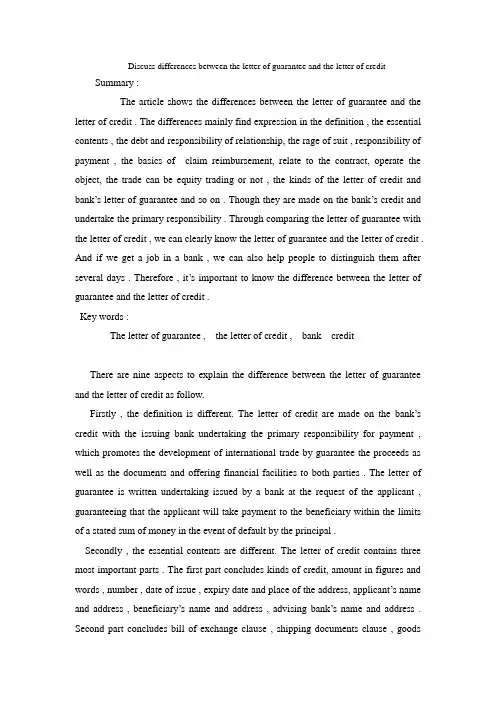
Discuss differences between the letter of guarantee and the letter of credit Summary :The article shows the differences between the letter of guarantee and the letter of credit . The differences mainly find expression in the definition , the essential contents , the debt and responsibility of relationship, the rage of suit , responsibility of payment , the basics of claim reimbursement, relate to the contract, operate the object, the trade can be equity trading or not , the kinds of the letter of credit and bank’s letter of guarantee and so on . Though they are made on the bank’s credit and undertake the primary responsibility . Through comparing the letter of guarantee with the letter of credit , we can clearly know the letter of guarantee and the letter of credit . And if we get a job in a bank , we can also help people to distinguish them after several days . Therefore , it’s important to know the difference between the letter of guarantee and the letter of credit .Key words :The letter of guarantee , the letter of credit , bank creditThere are nine aspects to explain the difference between the letter of guarantee and the letter of credit as follow.Firstly , the definition is different. The letter of credit are made on the bank’s credit with the issuing bank undertaking the primary responsibility for payment , which promotes the development of international trade by guarantee the proceeds as well as the documents and offering financial facilities to both parties . The letter of guarantee is written undertaking issued by a bank at the request of the applicant , guaranteeing that the applicant will take payment to the beneficiary within the limits of a stated sum of money in the event of default by the principal .Secondly , the essential contents are different. The letter of credit contains three most important parts . The first part concludes kinds of credit, amount in figures and words , number , date of issue , expiry date and place of the address, applicant’s name and address , beneficiary’s name and address , advising bank’s name and address . Second part concludes bill of exchange clause , shipping documents clause , goodsclause , transportation clauses and other or special terms and or conditions . The third part includes the instructions to negotiating bank , the issuing bank’s undertaking clause , the issuing bank’s name and signature , this documentary credit is subjected to UCP600. But the letter of credit includes five parts . The first part is the basic program which contains the guarantee’s number , issuing date , parties’name and address , relevant trade or name of program , relevant contract or biding document’s number and contracting or date of issue and so on . The second part is responsibility clauses which is main body forming bank’s letter of guarantee. The third part is guarantee amount that issuing bank or other financing organization bears the most amount . The third part is period of validity which is the latest claim date or be called expiry date . The five part is way of claim that means beneficiary can come up with claim to the issuing bank on any occasion . And for this condition , there are two ways to deal with it on the international. One way is first demand guarantee , another way is conditional guarantee.Responsibility of payment is different. For the letter of credit , issuing bank takes on the first responsibility of payment . And if the credit is available , the bank will pay at maturity . Sometimes , even though the credit is available , the bank could default of payment . But on the bank’s letter of guarantee operation , bank’s demand guarantee takes on the first responsibility of payment and bank’s accessary guarantee takes on the second responsibility of payment . In spite of principal agree with it or not or what is the real fact, the guarantee of bank must take the responsibility of payment when someone has a reasonable claim.The rage of suit is different . In general , the letter of credit applies to goods of trade . But the bank’s letter of guarantee can suit many aspects . It concludes international engineering contracting , tender and bid , debit and credit operation , repayment and advanced payment , maintenance and so on .The debt and responsibility of relationship is different. Once the letter of credit is created , the issuing bank means the principal debtor . But bank’s letter of guarantee is a guarantee certificate which takes the responsibility of payment and it takes the responsibility of absolute payment .The basics of claim reimbursement is different . The basic of claim reimbursement is shipping documents which are commercial bills on the letter of credit . But the basic of claim reimbursement is claim letter or other certificate document which can prove the default of principals.Relationship with the contract is different. The letter of credit , once issued , though it on the basis of the contract , such credit is a separate transaction from the sale of other contract on which it may be based and banks are in no way concerned with or bound by such contract , even if any reference whatsoever to it is included . In a word , the letter of credit is an independent and autonomic document . However , compared with the the guarantee agreement and guarantee , the transaction between the principal and the beneficiary is master contract. That is to say , the guarantee agreement is affiliated with the master contract and is affected all kinds of contains about the contract.Operating the objections is different. Regarding to the letter of credit , credit transaction is the trade dealing with documents and not with services , goods or other performance . Accordingly, on principle , when banks receives the documents submitted by the beneficiary , they usually examine the document or to make sure whether they comply with the terms and conditions of credit, and pay no attention to the discrepancies between the documents and the goods actually delivered by the beneficiary . As long as the documents presented by the beneficiary are in compliance with the terms and conditions of credit , the issuing bank or the nominated bank should be honor . The issuing bank and the nominated bank must examine a presentation to determine , on the basis of the documents alone , whether or not the documents appear on their face to constitute a complying presentation. In addition , what we need special emphasis is when the applicant finally receives the documents from the issuing bank ,whether he will accept or not should only depend on the documents’compliance with the credit . But for the bank’s letter of guarantee , the bank need to analysis and estimate the contract and the risk of the relevant details . The bank’s letter of guarantee must make sure the guarantee debt’s details , amounts , kind of the guarantee , cash of deposit , handling charge , the condition , date , theperiod of guarantee , the change of contract , the cancel of contract , the liability for breach of contract on the rule about the bank issuing the letter of guarantee. Under the circumstances, they know the owner of rights and obligations . Therefore , when the bank gets an applicant of guarantee , bank has a necessary to check the principal’s credit standing and respectability , status of debt , the details of guarantee and the operating risk . The reason why check these information is that the bank wants to reduce the risk up to the hilt .The functions between the letter of credit and bank’s letter of guarantee is different. For the letter of credit , the beneficiary can through negotiation to get the flow of cash. But as for bank’s letter of guarantee , unconditionally appropriated to the contract of document couldn’t be a evidence to claim and it wouldn’t be mortgage loan . So the beneficiary don’t get the capital turnover.the kinds of the letter of credit and bank’s letter of guarantee are different. Classification of letters of credit varies with different points of view . According to the attaching of documents , there are clean credit and documentary credit . According to the Revocability of credit , there are revocable credit and irrevocable credit . According to the adding of confirmation , there are confirmed credit and unconfirmed credit . According to the method of payment , there are sight credit , deferred credit , acceptance credit and negotiation credit . In addition , there are negotiation credit and anticipatory credit and transferable credit . However , types of bank’s letter of guarantee has less than the letter of credit . There are bid bond , performance guarantee , refund guarantee , loan guarantee , overdrawn guarantee , payment guarantee , guarantee for bond payment , leasing guarantee , quality guarantee , maintenance guarantee , retention money guarantee ,bail bond , customs guarantee , guarantee for compensation trade and so .That’s all the difference between the letter of credit and bank’s letter of guarantee . In the moment, it’s important to distinguish the details . After all , you know that and you can do it well . Thus , you can not only do better in your homework or your test, but also it’s very useful on your future work .。

课程名称:国际金融实务课程论文得分:课程论文题目以信用证业务为主的三种国际结算方式过程与比较班级商务英语132班学生姓名刘婷学生学号 030413216课程论文完成时间 2015年7月2日目录摘要 (3)关键字 (3)一、三种国际结算方式(汇款、托收和信用证)的含义及比较 (3)1、汇款(Remittance) (3)2、托收(Collection) (3)3、信用证(Letter of Credit) (3)二、三种国际结算业务的种类和业务流程 (4)1、汇款 (4)(1)电汇(Telegraphic Transfer,T/T)流程 (4)(2)信汇(Mail Transfer,M/T)流程 (4)(3)票汇(Remittance by Banker’s Demand Draft,D/D) (4)2、托收 (5)跟单托收(Documentary Collection)流程 (5)3、信用证一般流程 (6)三、三种结算方式的特点与比较 (6)1、汇款 (6)2、托收 (7)3、信用证特点与优点 (7)四、信用证条款与审单 (8)1、信用证主要条款 (8)2、信用证的审核 (9)五、总结 (10)参考文献 (10)摘要:改革开放以来,中国敞开国门,面向世界市场,大力发展国际贸易。
2011年中国加入世界贸易组织后,中国的对外贸易更是经历发展大潮,对外贸易总额从2000年的四千多亿美元发展到2013年的四万多亿美元,成为世界第一大贸易国。
国际结算业务作为国际贸易往来中关键性的一环,为越来越多从事国际贸易的人学习掌握,希望以对国际结算的熟悉来在实际贸易往来中占据一定优势。
本文旨在分析三大国际结算方式的过程与差别,以信用证为主谈谈这三种国际结算方式。
关键词:汇款、托收、信用证、国际结算方式一、三种国际结算方式(汇款、托收和信用证)的含义及比较1、汇款(Remittance):是一种顺汇方式,是债务人或付款人主动通过银行将款项汇交收款人的结算方式。
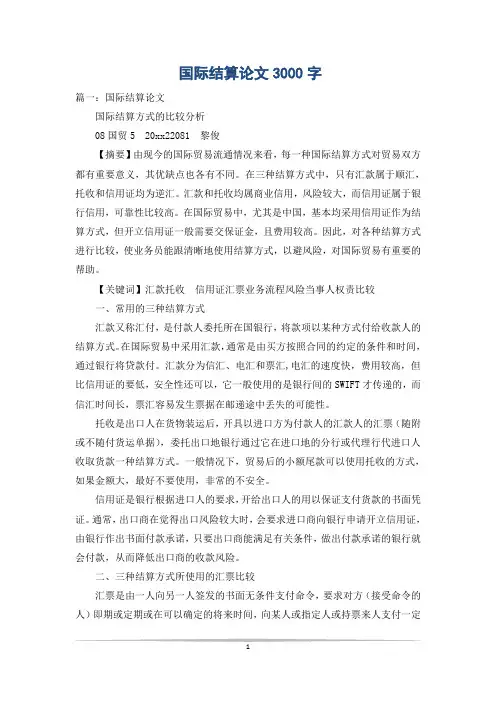
国际结算论文3000字篇一:国际结算论文国际结算方式的比较分析08国贸5 20xx22081 黎俊【摘要】由现今的国际贸易流通情况来看,每一种国际结算方式对贸易双方都有重要意义,其优缺点也各有不同。
在三种结算方式中,只有汇款属于顺汇,托收和信用证均为逆汇。
汇款和托收均属商业信用,风险较大,而信用证属于银行信用,可靠性比较高。
在国际贸易中,尤其是中国,基本均采用信用证作为结算方式,但开立信用证一般需要交保证金,且费用较高。
因此,对各种结算方式进行比较,使业务员能跟清晰地使用结算方式,以避风险,对国际贸易有重要的帮助。
【关键词】汇款托收信用证汇票业务流程风险当事人权责比较一、常用的三种结算方式汇款又称汇付,是付款人委托所在国银行,将款项以某种方式付给收款人的结算方式。
在国际贸易中采用汇款,通常是由买方按照合同的约定的条件和时间,通过银行将贷款付。
汇款分为信汇、电汇和票汇,电汇的速度快,费用较高,但比信用证的要低,安全性还可以,它一般使用的是银行间的SWIFT才传递的,而信汇时间长,票汇容易发生票据在邮递途中丢失的可能性。
托收是出口人在货物装运后,开具以进口方为付款人的汇款人的汇票(随附或不随付货运单据),委托出口地银行通过它在进口地的分行或代理行代进口人收取货款一种结算方式。
一般情况下,贸易后的小额尾款可以使用托收的方式,如果金额大,最好不要使用,非常的不安全。
信用证是银行根据进口人的要求,开给出口人的用以保证支付货款的书面凭证。
通常,出口商在觉得出口风险较大时,会要求进口商向银行申请开立信用证,由银行作出书面付款承诺,只要出口商能满足有关条件,做出付款承诺的银行就会付款,从而降低出口商的收款风险。
二、三种结算方式所使用的汇票比较汇票是由一人向另一人签发的书面无条件支付命令,要求对方(接受命令的人)即期或定期或在可以确定的将来时间,向某人或指定人或持票来人支付一定金额。
汇款时,通常会使用以下几种汇票:银行汇票是出票人和付款人均为银行的汇票。
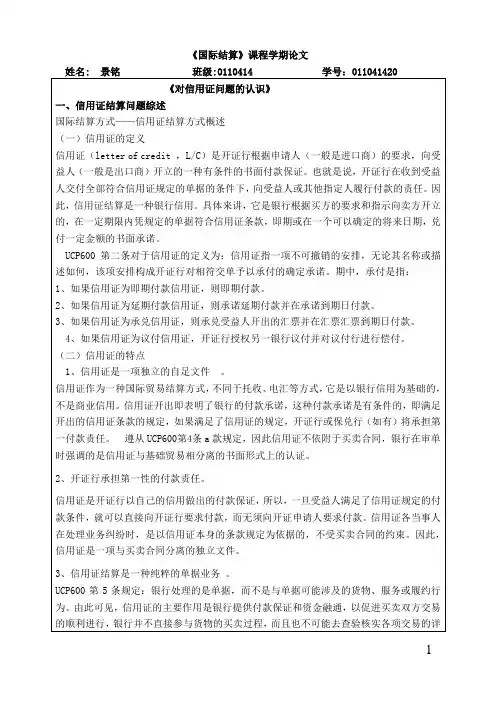
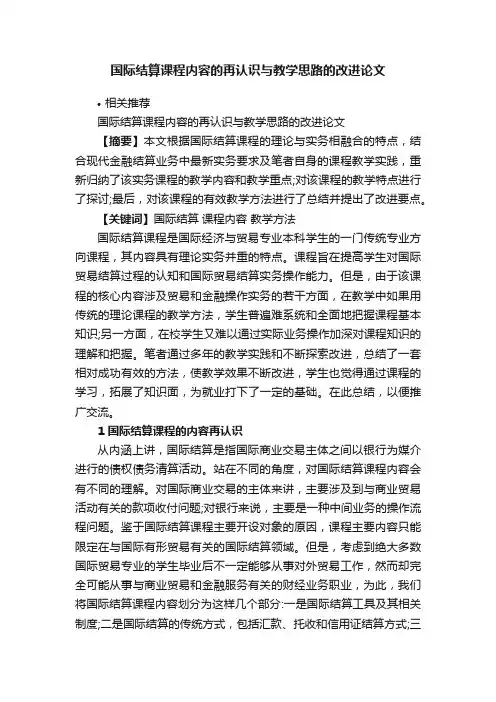
国际结算课程内容的再认识与教学思路的改进论文•相关推荐国际结算课程内容的再认识与教学思路的改进论文【摘要】本文根据国际结算课程的理论与实务相融合的特点,结合现代金融结算业务中最新实务要求及笔者自身的课程教学实践,重新归纳了该实务课程的教学内容和教学重点;对该课程的教学特点进行了探讨;最后,对该课程的有效教学方法进行了总结并提出了改进要点。
【关键词】国际结算课程内容教学方法国际结算课程是国际经济与贸易专业本科学生的一门传统专业方向课程,其内容具有理论实务并重的特点。
课程旨在提高学生对国际贸易结算过程的认知和国际贸易结算实务操作能力。
但是,由于该课程的核心内容涉及贸易和金融操作实务的若干方面,在教学中如果用传统的理论课程的教学方法,学生普遍难系统和全面地把握课程基本知识;另一方面,在校学生又难以通过实际业务操作加深对课程知识的理解和把握。
笔者通过多年的教学实践和不断探索改进,总结了一套相对成功有效的方法,使教学效果不断改进,学生也觉得通过课程的学习,拓展了知识面,为就业打下了一定的基础。
在此总结,以便推广交流。
1 国际结算课程的内容再认识从内涵上讲,国际结算是指国际商业交易主体之间以银行为媒介进行的债权债务清算活动。
站在不同的角度,对国际结算课程内容会有不同的理解。
对国际商业交易的主体来讲,主要涉及到与商业贸易活动有关的款项收付问题;对银行来说,主要是一种中间业务的操作流程问题。
鉴于国际结算课程主要开设对象的原因,课程主要内容只能限定在与国际有形贸易有关的国际结算领域。
但是,考虑到绝大多数国际贸易专业的学生毕业后不一定能够从事对外贸易工作,然而却完全可能从事与商业贸易和金融服务有关的财经业务职业,为此,我们将国际结算课程内容划分为这样几个部分:一是国际结算工具及其相关制度;二是国际结算的传统方式,包括汇款、托收和信用证结算方式;三是国际结算的新发展,如国际保付代理、福费廷业务等等。
每一个部分都包含着极其丰富的具体内容。
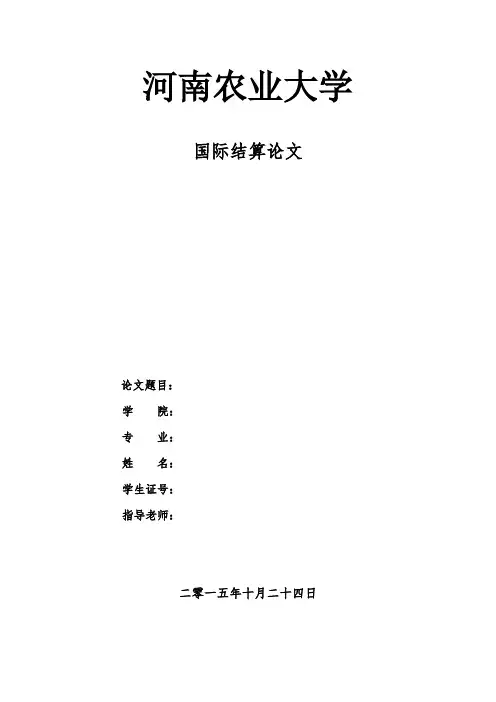
河南农业大学国际结算论文论文题目:学院:专业:姓名:学生证号:指导老师:二零一五年十月二十四日目录摘要 (3)一、信用证支付方式下顺利结汇的原则.................................................................. ..3二、信用证软条款与风险.................................................................. .. (3)1.信用证软条款对卖方收汇的影响................................................................... . (3)2.信用证软条款表现方式................................................................... .. (4)三、议付单据的制作.................................................................. . (7)四、结束语.................................................................. . (9)参考文献................................................................... .. (9)信用证软条款与收汇风险摘要在国际贸易业务中,信用证是最常用的支付方式。
许多人认为信用证付款方式对出口商结汇是最安全的,其实并不然。
文章针对信用证中的软条款及其对出口商收汇的影响进行分析,提出应防范的风险。
随着世界经济的发展,国际贸易业务越来越频繁,国际贸易业务方式更趋于单据化。
信用证是一种银行开立的有条件的承诺付款的书面文件,属银行信用。
为保证各自利益,越来越多的贸易双方在进行国际贸易业务时,多采用信用证作为支付方式。
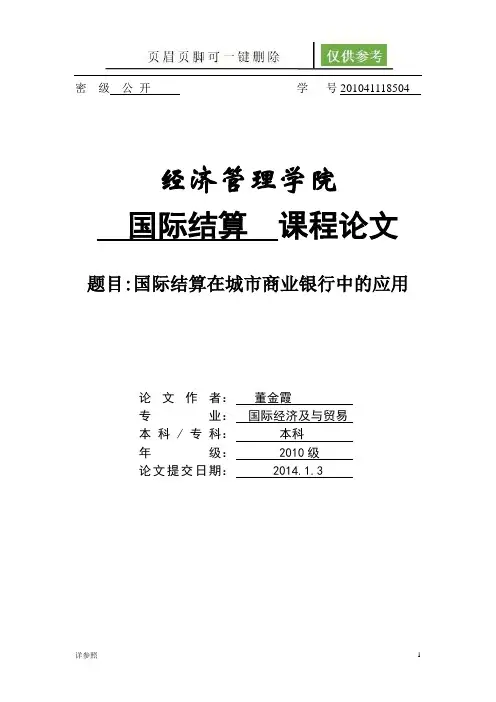
密 级 公 开 学 号201041118504经济管理学院 国际结算 课程论文题目:国际结算在城市商业银行中的应用论文作者 专业 本科/专科 年级 论文提交日期 ::::: 董金霞国际经济及与贸易本科 2010级2014.1.3国际结算在城市商业银行中的应用摘要:近几年来,城市商业银行取得了长足的发展,在资产大幅提升,资产质量全面改善,本币业务的规模和效益发展到一定程度的背景下,纷纷开办外汇业务。
城市商业银行作为开办外汇业务的新主力军,在近几年表现得特别抢眼。
但是绝大部分城市商业银行在外汇业务领域目前并没有大的作为。
那么城市商业银行在开展国际结算业务过程中存在哪些问题?如何解决这些问题?是许多城市商业银行在激烈的竞争中发展国际结算中业务亟待解决的问题。
关键词:城市商行国际结算单证中心一、城市商业银行国际结算简介城市商业银行的一项基础业务类属中间性业务是国际结算业务。
通过两国银行办理的由贸易或非贸易引起的债权债务的清偿,它以国际贸易为前提,国际结算过程存在多重风险,但风险不等于损失,操作得当,风险可以预防,可以转化为收益;如不当,风险即会成为损失,同时,国际结算涉及到国家金融管理的有关法令、外汇管理条例、国际惯例与准则、银行信誉、银企责任及业务的具体操作等诸多方面,比较复杂。
随着中国加入世贸组织,我国的进出口贸易和外向型经济将会有更快的发展。
这一切为国际结算业务的快速发展提供了有利条件。
二、城市商业银行国际结算业务发展现状国际结算业务是商业银行国际业务的核心部分,是商业银行在全球范围内开展的一项业务活动,它能够给商业银行带来较高的利润,加强商业银行与国际公司的合作,开拓和巩固重要客户关系,从而带动商业银行其他业务的发展。
但是,相伴而来的是银行结算风险大大增加,风险一旦成为事实,不仅是客户资金受损失,失去现有的和潜在的顾客群,而且银行也将在利润上受到巨大损失,同时对银行的声誉也造成损害。
因此,创建符合业务发展要求和管理需要的国际结算业务风险管理体系是我国银行管理者面临的新挑战。
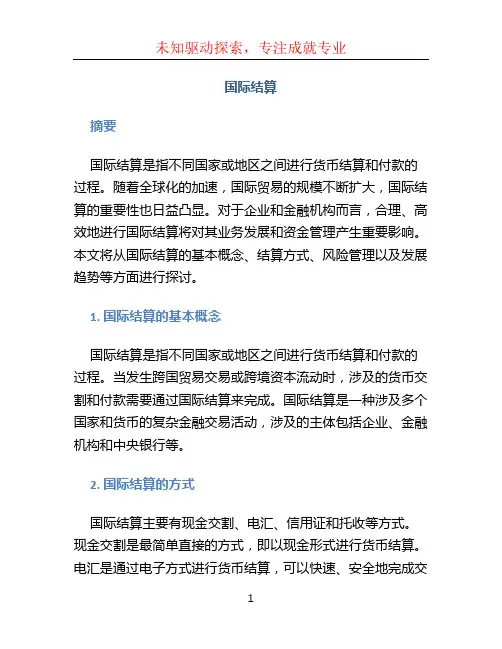
国际结算摘要国际结算是指不同国家或地区之间进行货币结算和付款的过程。
随着全球化的加速,国际贸易的规模不断扩大,国际结算的重要性也日益凸显。
对于企业和金融机构而言,合理、高效地进行国际结算将对其业务发展和资金管理产生重要影响。
本文将从国际结算的基本概念、结算方式、风险管理以及发展趋势等方面进行探讨。
1. 国际结算的基本概念国际结算是指不同国家或地区之间进行货币结算和付款的过程。
当发生跨国贸易交易或跨境资本流动时,涉及的货币交割和付款需要通过国际结算来完成。
国际结算是一种涉及多个国家和货币的复杂金融交易活动,涉及的主体包括企业、金融机构和中央银行等。
2. 国际结算的方式国际结算主要有现金交割、电汇、信用证和托收等方式。
现金交割是最简单直接的方式,即以现金形式进行货币结算。
电汇是通过电子方式进行货币结算,可以快速、安全地完成交易。
信用证是银行在买卖双方之间开立的一种保证付款的凭证,可以有效地降低交易风险。
托收是指银行按照指示收取卖方的货款,并将货款支付给买方,作为一种中介服务的方式。
3. 国际结算的风险管理国际结算涉及多个国家和货币,存在着一定的风险。
主要包括货币风险、信用风险和支付风险等。
货币风险是指由于汇率波动导致结算中的货币价值发生变化的风险。
信用风险是指买卖双方之间的信用问题,如违约风险。
支付风险是指由于支付方式和渠道问题导致的结算风险。
为了降低风险,国际结算需要采取相应的风险管理措施,包括合理选择结算方式、加强信用评估和采取适当的支付保障措施等。
4. 国际结算的发展趋势随着互联网和金融科技的快速发展,国际结算也面临着新的挑战和机遇。
一方面,互联网和金融科技为国际结算提供了更加便捷和高效的方式,如在线支付和区块链技术等。
另一方面,国际结算也面临着数据安全和监管等方面的挑战。
未来国际结算的发展趋势将更加注重技术创新和风险管理的平衡,以提高结算效率和降低结算风险。
结论国际结算是国际贸易和跨境资金流动的重要环节,对企业和金融机构的业务发展和资金管理具有重要影响。
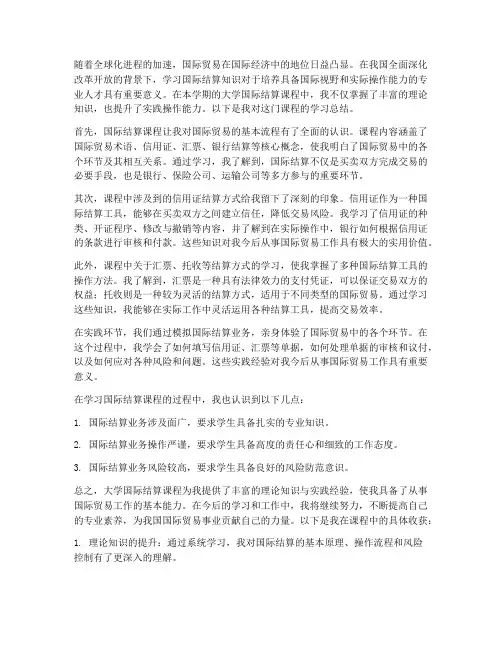
随着全球化进程的加速,国际贸易在国际经济中的地位日益凸显。
在我国全面深化改革开放的背景下,学习国际结算知识对于培养具备国际视野和实际操作能力的专业人才具有重要意义。
在本学期的大学国际结算课程中,我不仅掌握了丰富的理论知识,也提升了实践操作能力。
以下是我对这门课程的学习总结。
首先,国际结算课程让我对国际贸易的基本流程有了全面的认识。
课程内容涵盖了国际贸易术语、信用证、汇票、银行结算等核心概念,使我明白了国际贸易中的各个环节及其相互关系。
通过学习,我了解到,国际结算不仅是买卖双方完成交易的必要手段,也是银行、保险公司、运输公司等多方参与的重要环节。
其次,课程中涉及到的信用证结算方式给我留下了深刻的印象。
信用证作为一种国际结算工具,能够在买卖双方之间建立信任,降低交易风险。
我学习了信用证的种类、开证程序、修改与撤销等内容,并了解到在实际操作中,银行如何根据信用证的条款进行审核和付款。
这些知识对我今后从事国际贸易工作具有极大的实用价值。
此外,课程中关于汇票、托收等结算方式的学习,使我掌握了多种国际结算工具的操作方法。
我了解到,汇票是一种具有法律效力的支付凭证,可以保证交易双方的权益;托收则是一种较为灵活的结算方式,适用于不同类型的国际贸易。
通过学习这些知识,我能够在实际工作中灵活运用各种结算工具,提高交易效率。
在实践环节,我们通过模拟国际结算业务,亲身体验了国际贸易中的各个环节。
在这个过程中,我学会了如何填写信用证、汇票等单据,如何处理单据的审核和议付,以及如何应对各种风险和问题。
这些实践经验对我今后从事国际贸易工作具有重要意义。
在学习国际结算课程的过程中,我也认识到以下几点:1. 国际结算业务涉及面广,要求学生具备扎实的专业知识。
2. 国际结算业务操作严谨,要求学生具备高度的责任心和细致的工作态度。
3. 国际结算业务风险较高,要求学生具备良好的风险防范意识。
总之,大学国际结算课程为我提供了丰富的理论知识与实践经验,使我具备了从事国际贸易工作的基本能力。

国际结算论文Pleasure Group Office【T985AB-B866SYT-B182C-BS682T-STT18】班级:商英四班姓名:杨梦南对《国际结算》问题的探讨——票据浅谈摘要国际结算是伴随着国际贸易的扩大而产生和发展起来的,对各国的经济发展都发挥了至关重要的作用。
它主要研究国际间债权债务的清偿,以及时候使用的信用工具、结算方法和各种必要的单据。
国际结算促进了各国的经济发展,保证了经济全球一体化的正常运行。
通过使各国的产品,服务和资金得以交换,国际结算使生产得到比国内市场更宽阔的发展空间,从而实现了更大规模的持续发展;通过使资金实现国际转移,国际结算实现跨国投资,在全球范围内配置资源,促进了生产力的发展,以得到最大的收益。
[1]作为一门学科,国际结算的研究对象包括国际结算工具,国际结算单据,以银行为中心的支付体系,和国际结算方式。
在国际结算中,无论采用何种结算方式,大都与票据息息相关。
如汇款中使用的票汇,光票托收中使用的汇票,支票,本票等各种票据,跟单托收、信用证中使用的汇票等。
关键词:国际结算结算方式票据汇票支票本票这一个学期的对国际结算课课学习,使我从对于这门课程没有一点概念到现在了解了国际结算的理论知识和大概的实际操作过程.国际结算就是运用一定的金融工具(汇票、本票、支票等),采取一定的方式(汇付、托收、信用证等),通过一定的媒介机构(银行或其他金融机构等),进行国与国之间的货币收支行为,从而使国际间债权债务得以清偿。
而且,国际结算既是一门实务性很强的学科,又是一门理论较深的学问。
国际结算涉及的方面有很多,就此,我对于其中关于票据的一部分进行分析,以下是对票据的一个基本介绍与浅析。
票据是商品经济发展到一定阶段的产物。
世界上最早使用的交易方式是“以货易货”,随着商业活动随着商业活动的逐步发展,才使用货币作为收付结算手段,即买方和卖方均使用现金,这相对于以货易货来说,有了质的飞跃。
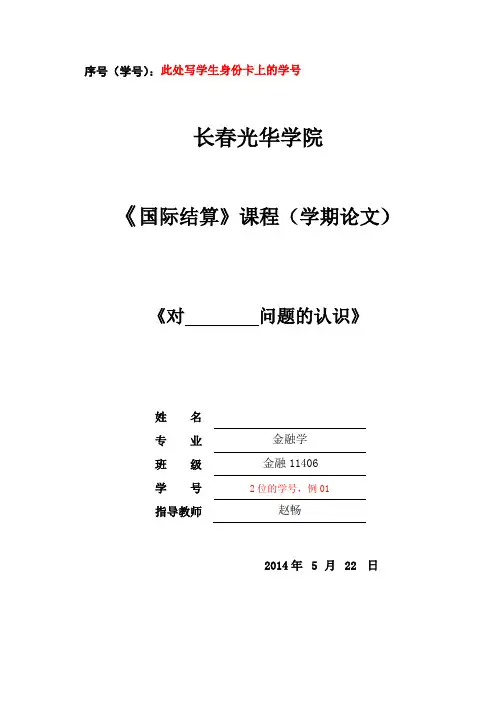
论文主要结构一、二、三、四、结论五、参考文献对问题的认识[摘要] 本文通过对长吉图开发开放先导区以及先导区的对外经济合作问题的阐述,针对长吉图开发开放先导区对外经济合作对吉林省经济发展影响进行系统分析,研究长吉图开发开放先导区近些年来的对外经济合作在促进吉林省经济增长中存在的问题,并提出对策,从而更好的促进长吉图开发开放先导区发展方向。
(注:对全文的高度概括与总结)[关键词]长吉图开发开放先导区对外经济合作对策建议(注:关键词3到5个)注:可以手写,也可以打印论文,但打印的论文,正文的字体必须为宋体,字号必须是小四,行间距20磅。
如上交的论文格式不对,成绩则视为不及格或必须重新提交。
论文内容不得有超过50%的雷同,如有雷同,两份均记0分。
且论文总字数不少于2000字,在打印输出论文前,请将注释删除。
一、问题综述(一)的含义(二)的特点1.2.3.(三)的作用二、问题发展现状及面临的问题(一)发展现状1.2.3.(二) 面临的问题及其成因1.2.3.4.三、问题的解决对策及发展前景(一)解决对策1.2.3.4.(二)发展前景1.2.3.四、结论五、参考文献[1] 王胜今.论长吉图开发开放先导区建设与发展战略.社会科学战线. 2010(3): 7—13.[2] 邴正.长吉图开发开放先导区建设与东北亚区域合作.西伯利亚研究.2010(3):28—31.[3] 李昌南.陈国喜.长吉图开发开放先导区建设面临的问题及其对策.延边大学学报(社会科学版).2010(3):19-23.[4] 马宇坤.长吉图开发开放先导区对外贸易与吉林省经济发展关系的实证研究.吉林财经大学.2012(5):8-13[5] 赵贞海 .长吉图地区高新技术产业布局与区域经济发展研究.延边大学.2012:7-15。
国际结算论文3000字【三篇】【篇一】国际结算论文3000字【摘要】国际结算是国际贸易专业的专业课程,具有理论与实践紧密结合的特点。
传统的理论讲授方法无法满足课程需要,必须采用案例教学法提高教学效果。
而案例教学法的运用具有其特殊性,本人在多年的实际教学经验总结基础上,提出了实施案例教学法时的注意事项。
【关键词】国际结算案例教学法1.国际结算课程的特点国际结算课程主要以国际贸易的支付方式和支付工具为授课内容,要求掌握各种支付方式的特点、流程和风险,会运用合适的支付工具完成国际资金转移,并利用各种结算规则和惯例解决实际问题。
该课程所涉及的知识极为广泛,是金融、贸易、保险、法律的多边交叉学科,并具有很强的实用性和可操作性。
传统的教学方式以教师讲授为主,由于内容太多、太细,难以整体把握教学深度与精度;而对于从未涉足实务的学生而言,理论教学尤显空泛。
除内容繁杂细琐外,该课程还需要培养学生实际的业务操作能力。
对于习惯了“死记硬背”的学生而言,就显得相对难以把握,考核时,拿分最低的往往是案例分析和模拟操作这类的大题。
鉴于国际结算课程的特点,有必要采用新的教学方法提升教学效果。
2.国际结算案例教学的特殊性要打破“教师讲、学生记”的满堂灌式教学,就必须将学生置于真实的经济活动中,让他们身临其境地作为某一当事人去思考,因此有必要选用国际结算业务中,真实发生的具有代表性的事情作为案例,采用案例教学法进行授课。
在国际结算课程中运用案例教学法具有以下特殊性:2.1案例参与者众多,涉及内容复杂国际结算的案例涉及参与者众多,包括银行、进出口商、物流企业、保险公司、海关等。
这些参与者之间形成了复杂的业务网络和利益关系,在阅读案例时首先必须理顺关系才能进行讨论。
其次,案例涉及的业务流程复杂,包括贸易履约流程、货物运输流程和结算流程。
不同的贸易方式、结算方式和支付工具其流程差异大,同时各流程之间相互影响,因此学生必须梳理案例中的流程。
国际结算方式的风险管理策略论文国际结算方式的风险管理策略论文国际结算方式的风险管理策略论文【1】摘要:随着经济全球化的进程不断加快,国际间的贸易交流与合作也越来越频繁,但是在国际贸易不断发展的同时,也存在着一些问题,这些问题的存在将会严重影响国际贸易的进一步发展。
本文将结合国际贸易发展的现状,对国际结算方式的风险管理进行仔细的研究,并提出合理的风险管理策略,促进国际贸易的有序发展。
关键词:国际结算方式;风险;管理策略;分析研究国际结算是国际贸易中的一个重要环节,同时也是关系着国际贸易是否成功完成的关键步骤。
一般来说,国际贸易结算分为无形的贸易和有形的贸易两个主要类别,通过国际结算的实现,可以促进国家间的经济交流,实现国际金融的流动。
但是面对国际结算中存在的风险,必须要加以重视,采取合理的方案,来对进出口企业进行管理,进一步减少国际结算风险的影响。
一、国际结算方式中存在的风险因素1.托收方式中存在的风险因素对于托收方式的国际结算来说,它得以实现的基础是商业信用,通过建立商业信用,来促进贸易的实现。
简单来说,就是采取先运输商品后付款的方式,这种方式使得商品输出方需要承担巨大的贸易风险。
这种托收的国际结算方式的风险体现在:如果采购方出现延期付款或者是不付款的情况,那么一旦商品输出方出现资金链断裂的情况,就会给生产商造成严重的财务危机;除此之外,如果采购方并没有获得本国的一个进口许可证,那么就会导致货物无法进入,这就会给输出方带来严重的风险,所以必须要托收方式中存在的风险因素,进行充分的考虑。
2.汇付方式中存在的风险因素汇付也是一种常见的国际结算方式,一般采取的汇付方式就是预付货款与货到付款两种。
预付货款就是指先交付一部分定金,余款要等到货物到达后没有出现任何质量问题,在交付剩下的款项;而货到付款,则指要等到收货方收到货物后,并且进行确认后再将款项汇至出口商。
简单来说,这两种汇付方式都不利于出口商的利益,因为一旦进口商认为货物存在问题,那么就会全部退回,这样一来就会给出口商造成严重的经济影响。
人民币升值情况下的我国国际贸易多元化问题研究摘要2005年7月21日中国人民银行发布公告称:自即日起,中国开始实行以市场供求为基础、参考一篮子货币进行调节、有管理的浮动汇率制度。
自此以后,人民币兑美元汇率屡创新高,步入持续稳步升值的上升通道。
人民币不断升值的压力,必然对我国的国际贸易,从而也对我国的国际贸易结算带来显著的影响。
如何抵御人民币升值压力,防范国际结算风险已成为我国进出口企业不可回避的问题。
论文首先在前人的基础上更进一步研究了人民币升值的短期趋势;对各种传统的国际贸易结算方式及特点进行了阐述;并结合实务,详细分析了在当前人民币不断升值背景下我国国际贸易结算中存在的问题。
随后,文章总结了国际贸易结算多元化产生的原因和优势,探讨了人民币升值对国际结算多元化的影响,并根据作者本人曾有的外贸经验,从一个崭新的视角,提出了人民币升值背景下国际结算多元化的主张,强调大力发展国际保理等新型的、综合性的国际结算方式,采用结算多元化的策略抵御人民币升值风险,增强我国企业的竞争力。
论文最后还对我国实施国际结算多元化策略提出了具体的可操作的措施和一些有益的建议,希望能为我国进出口企业或相关职能部门的决策提供依据和参考。
本文的创新在于:本文在前人的基础上结合实务,从一个崭新的视角,提出了人民币升值背景下加快国际结算多元化的主张,强调大力发展国际保理等新型的、综合性的国际结算方式抵御人民币升值风险,增强我国企业的竞争力。
论文对我国实施国际结算多元化策略提出了具体的可操作的措施和一些有益的建议,这点在以前的文献中还十分少见,所以本研究具有很强的现实指导意义和新意。
关键词:人民币升值国际贸易结算多元化The appreciation of the renminbi under the background of the our country international trade settlement diversity research problemsAbstractJuly 21, 2005, the people's bank of China issued announcement says: from now on, China began to implement based on market supply and demand and the reference to a basket of currencies, managed floating exchange rate system. Since then, the yuan against the dollar exchange rate reached new highs, into the steady rise of the value of the channel. The pressure on the appreciation of the RMB constantly, necessary for our country's international trade, and also to our country the international trade settlement bring about significant influence. How to prevent cny appreciation pressure, guard against international settlement risk has become China's import and export enterprise inevitable problems.It firstly in the basis of former further studies the yuan appreciation of the short term trend; To all sorts of traditional international trade settlement way and characteristics expatiated; And combined with practice, the paper analyses in the current RMB appreciation in our country under constant background of international trade settlement problems. Then, this paper summarizes the international trade settlement the causes of diversification and advantage, discusses the appreciation of the renminbi to international settlement of the diversification of influence, and based on the author I have had some experience in foreign trade, from a new Angle of view, put forward under the background of the appreciation of the renminbi international settlement of claims to the diversification, emphasis on developing international factoring and so on the new, comprehensive international settlement way, USES the settlement of diversification strategy against the appreciation of the renminbi risks, strengthen the competitiveness of the enterprises in our country. The paper on China's implementation of international settlement diversity Strategy put forward specific operational measures and some useful Suggestions,hoping for our import and export enterprise or related functional departments of the decision provides the basis and the reference.The innovation of this paper is that in this paper on the basis of predecessors combined with practice, from a new Angle of view, put forward under the background of the appreciation of the renminbi to speed up the international settlement of claims to the diversification, emphasis on developing international factoring and so on the new, comprehensive international settlement way against the appreciation of the renminbi risks, strengthen the competitiveness of the enterprises in our country. Papers on the implementation of international settlement diversification strategy put forward specific operational measures and some useful Suggestions, this in the past in the literature is very rare, so this study has the very strong realistic meaning and new idea.Key words: The appreciation of the renminbi risk prevention international trade settlement diversity目录摘要 (Ⅰ)Abstract (Ⅱ)1、绪论 (1)1.1研究背景 (1)1.2研究意义 (3)2、人民币升值对国际结算的影响 (6)2.1汇改以来人民币处在持续稳步升值的刚性趋势中 (6)3、汇款方式及特点 (6)3.1传统付款方式 (7)3.2信用证方式及特点 (8)4、买方市场环境下,国际结算方式已经成为外贸竞争的有效手段 (9)4.1 传统的国际结算方式已经不能满足现代国际贸易结算要求 (10)4.2现代商业银行等金融机构可以在国际结算中提供多层次中介服务 (10)5、国际贸易结算多元化的优势分析 (11)5.1优势分析 (11)5.2降低了交易的成本,提高了商品在国际市场上的竞争能力 (11)5.3有利于综合性风险规避机制的建立 (12)6、人民币升值加速了我国国际贸易结算多元化趋势 (12)6.1我国国际贸易结算方式正在发生深刻变化 (12)6.2人民币升值必将加速我国国际贸易结算多元化的趋势 (13)6.3推进我国国际贸易结算多元化的具体措施 (13)6.4保理业务的基本运作模式 (14)结论 (15)参考文献 (16)1、绪论1.1研究背景2005年7月21日,中国抓往时机进行了“出其不意弦的汇率改革。
《国际结算》课程双语教学之利弊分析的论文《国际结算》课程双语教学之利弊分析的论文论文导读:国际结算》的性质。
双语教学“遍地开花”。
国际结算》课程进行双语教学的利弊分析。
论文关键词:国际结算,双语教学,利弊分析一、引言教育部早在2001年就颁发了《关于加强高等学校本科教学工作提高教学质量的若干意见》,明确提出要在高校积极推动使用英语等外语进行教学,同时针对一些特殊专业和方向还提出了具体的指标要求:“高新技术领域的生物技术、信息技术等专业,以及为适应我国加入WTO后需要的金融、法律等专业,更要先行一步,力争三年内,外语教学课程要达到所开课程的5%至10%”。
无疑,这是针对新形势下,教育部给各高校下的“新任务”,目的是为了要培养外向型、应用型的国际人才。
随着我国对于国际事务的参与度越来越高,国家不仅仅需要能够掌握各门专业知识的人才,更需要这些专门人才能够走向国际,迎接机遇与挑战。
那么首先考虑到的就是要过“语言关”。
因此,双语教学“遍地开花”,各高校纷纷开始开发双语课程,而双语教学也就渐渐成为各高校进行对外宣传,提高知名度的一件“法宝”,进而成为衡量教学质量的必备条件之一。
二、相关基本概念(一)《国际结算》的性质国际结算是一项国际银行业务,指为清偿国际间债权债务关系或跨国转移资金而通过银行来完成的跨国(地区)货币收付活动。
《国际结算》课程教授的主要内容包括三大部分:国际结算的工具、国际结算的方式和国际结算的单据。
(二)双语教学的概念和起因现在针对双语教学的理解,一般都来源于由西格恩(Siguan)和麦凯(Mackcy)(1999)给出的定义:“‘双语教学’这个术语教育学论文,是指一个把两种语言作为教学媒介语的教育体系。
其中的一种语言往往是——但不一定是——学生的第一语言。
”[①]那么,在我国,这两种语言,多数则为汉语和英语。
之所以会提出双语教学,根据不同的课程,基本上可以分为以下两种解释:一种是指双语教学是“手段”,即一般指的是非外语专业的学生学习本专业的核心课程时,为了提高学生对于专业知识的掌握,而以“双语”作为新型教学手段;另一种是指双语教学为“目标”,即一般认为是针对外语类专业的学生,他们在校学习的目标即为掌握外语,那么通过“双语”甚至于“纯外语”教学的过程就是学生学习并达到掌握另一门语言(外语)应用方法和技巧这一目标的过程。
国际结算单证实训目录一、实训目的二、实训内容及过程三、实训中遇到的问题及解决途径四、经验总结国际结算单证实训一、实训目的1、学会实际填制国际汇票、本票和支票。
2、学会向银行申请汇付、托收和开立信用证,并填制相关申请单证。
3、学会作为出口方审核信用证,找出不可接受点。
4、学会制作信用证项下的单据,并进行审单。
二、实训内容及过程1、向交易公司发盘询价(建立合作关系、询盘、还盘、接受、建立交易合同进行贸易接洽)在国际贸易中,若交易目标公司不是合作伙伴关系,可以先发善意友好邮件建立关系,在建立力合作关系的基础上,进行询盘、还盘、接受、建立交易合同等流程来进行贸易合作。
询盘也叫询价,是指交易的一方准备购买或出售某种商品,向对方询问买卖该商品的有关交易条件。
询盘的内容可涉及:价格、规格、品质、数量、包装、装运以及索取样品等,询盘不是每笔交易必经的程序,如交易双方彼此都了解情况,不需要向对方探询成交条件或交易的可能性,则不必使用询盘,可直接向对方发盘。
发盘也叫发价,指交易的一方(发盘人)向另一方(受盘人)提出各项交易条件,并愿意按这些条件达成交易的一种表示。
发盘在法律上称为要约,在发盘的有效期内,一经受盘人无条件接受,合同即告成立,发盘人承担按发盘条件履行合同义务的法律责任。
发盘多由卖方提出。
也可由买方提出,也称递盘。
实务中常见由买方询盘后,卖方发盘,但也可以不经过询盘,一方迳直发盘。
受盘人不同意发盘中的交易条件而提出修改或变更的意见,称为还盘。
在法律上叫反要约。
还盘实际上是受盘人以发盘人的地位发出的一个新盘。
原发盘人成为新盘的受盘人。
还盘又是受盘人对发盘的拒绝,发盘因对方还盘而失效,原发盘人不再受其约束。
还盘可以在双方之间反复进行,还盘的内容通常仅陈述需变更或增添的条件,对双方同意的交易条件毋需重复。
接受是指受盘人在发盘的有效期内,无条件地同意发盘中提出的各项交易条件,愿意按这些条件和对方达成交易的一种表示。
Three methods of the international paymentsThe three methods of the international payments are remittance、collection and letters of credit.RemittanceRemittance, as a frequent payment method in international trade , refers to the transfer of funds from one party to another among different countries. Remittance, which is always used by those import enterprise, indicating the bank to a certain way pay a certain sum of money to the export enterprises. Now the World Bank generally use the remittance way, as SWIFT system treatment telegraphic transfer (T/T). By remittance, the goods’ direct payment provided by import enterprise is paid to export enterprise, while the documents representing the goods by the export enterprise directly submitted to import enterprise. Payment and the order of the shipment, directly determine the size of import and export both in case of any risks. Practically, some import enterprises’ remittance is divided into former T/T and after T/T j before the so-called roughly the equivalent of advance payments, T/T roughly equivalent to cash on delivery. Obviously, if export enterprise products’ market is competitive, it can make proper requirements before T/T import enterprise pay the cost only if the import and export both have good credit and credit after T/T is stable and powerful tool for orders.CollectionA collection means an arrangement whereby the seller draws a draft on the buyer and authorizes its bank to collect the money from the buyer . Collection differentiates from open account or cash in advance.Collection is pointed out in the shipment of the goods after mouth enterprise issued by financial documents and commercial documents, entrust its bank through the collecting bank which import enterprise is located to its payment. Specifically, under different way remittance export enterprise, the collection ofwhole set of documents transmitting through Banks. Import and export enterprise bear risks are relatively small, because only export enterprise after the shipment of the goods can tip documents. At the same time import enterprise pays or accepts samples according to the document can be achieved. Collection can be classified into two types, one is against payment (D/P), one is accepted (D/A). Generally speaking, d/p has lower risk than d/a, because export enterprises’ prompt payment is received, or still control the goods. D/A holds as long as import enterprise acceptance, the bank will release the documents. But import enterprise acceptance is totally commercial creditable, expire to pay no payment still depend on import companies credit.Letter of creditA letter of credit is a conditional written undertaking by the issuing bank to pay money, because payment is upon presentation of a draft or written demand for payment together with specified documents.L/C refers to the issuing bank that import enterprise request, made a study on the complying presentation to honor the firm commitment. It is the bank credit intervention in the product of payment in international trade. It will appear not only in largely solved the problems between import and export enterprises in the contradiction about mutual distrust, but also can make both sides in the payment process access to bank financing in convenience. However, the Banks made promises for the confirmation as conditional, namely, the presentation is complying. If documents with discrepancies, issuing bank dishonored documents in accordance with the rules can be use as rules. Export enterprises in documents under construction and repair system, L/C must pay extra attention and be more cautious, in strict compliance with the terms and conditions of the credit. Therefore, the L/C made for export enterprise in full payment according to ability and level of underlying demand is higher. But currently, our country foreign trade enterprise, especially small andmedium-sized ones, lack high quality documentary personnel, in other words, the business level needs to improve.The character of the three methodsRemittanceOne, big riskRemittances foundation is commercial with their after delivery, the exporter can recover smoothly in payment, the importer success in advance payments after receipt of goods in conformity with the contract depends on her, namely separately. The importer or exporter prestigeTwo, finance burden imbalanceIf is cod, by exporters are funding burden; If a prepaid payment by the importer, the funding in settlement shoulders, and in the process from the bank, importers and exporters cannot get trade financing.Three, settlement of simple, rapid and low costRemittance settlement procedures simple, cheap, and settlement quickly. If trade mutual comparison trust, remittances settlement is very ideal pay or settlement.Generally speaking, the remittance settlement is a beneficial to importers and exporters of unfavorable settlement. Because, the current international market mainly is a buyer's market, the remittance settlement is generally cod not advance payments. Money and risk are made by exporters to assume. CollectionCollection of the risk is bigger, to the exporter shall than D/A risk of D/P more big. Documentary collection means after the first delivery, payment, therefore it shall risk is bigger. Payment by import business reputation, if he imported people went bankrupt, the loss of payment ability, or after shipment importcargo import prices, who refuses to pay, or import excuse who had not received the import license, or didn't get into foreign exchange, forbidden import or unable to pay foreign exchange, the exporter shall not only cannot recover payment on time, also may cause the loss of payment two empty. Collection of imported people more favorable, the formalities can rent issuing and advance deposit, and can borrow goods gets the convenience. Of course collection of imported men aren't no risk. If, after paying acquired imported shipping documents, and obtain goods, if the goods are found not in conformity with the contract, or simply false, will therefore losses, but overall, collection of imported people better, too.Letter of creditAdvantage1, A bank credit participation, a lower risk DP, DA and after T/T is related to the business risks, and L/C is a bank risk, the bank generally has a certain scale, and pay attention to the intangible value, so relatively safe.2, The constraints of UCP600 art.4 (b), trade by both sides trading cautious degrees higher.3, From the side can examine buyers strength. Buyers need to hand in the L/C must deposit, margin ratio of buyer's credit and depends on how much power. If the buyer can open big l/c, we can determine from flank buyer strength.4, Even if be dishonored, exporters still can control cargo right, the loss is relatively rare.Disadvantage1, Documents more demanding, prone to discrepancies dishonored.2, Cost is higher, affect exporters profits. L/C involving the advising charges reading-writing-discussion paying, the discrepancies fee, so many costs, if the credit amount is small words, cost more than 1% combined will.3, Encounter soft terms trap. Common soft terms has a guest inspection terms, 1/3 since send terms and air bill of lading terms, these clauses mean exporters to give up the title to the goods, eventually end up two empty "money" aspect. 4, Special national credit risk. Such as Bangladesh L/C, operation, often appear extremely standard bank of the release of the documents without authorization.5, Bank risk. Ultimately, the bank is enterprise, also exist their credit risk. Especially abroad, bank admittance threshold is very low, the bank the good and bad are intermingled, a small Banks credit worthy.In international trade, a deal, import and export of payment through consultation to determine the parties may, is usually one of the above three introduced. According to different situations, such as different trading commodities, different transaction object, different trading habits etc, import and export both sides can completely combined payment to settlement, which will be two or more payment combinations. Common form: L/C with the remittance combination, L/C with collection combination, remittance and collection combination, etc. Of course, the flexible combination and pay the way the premise is, by a foreign trade enterprise to a thorough understanding and mastering the basic payment. If used properly, combination payment can reduce costs more conducive to close the sale, favors the safety, and properly handle cases timely payment, better realize the win-win import and export enterprise.Pairwise combinationLetter of credit and CollectionThis is a deal with the payment, pay, part L/C and the balance by collection way settlement. The combination forms of practice is usually: the l/c beneficiary, the exporter shall open a prescribed two draft) belongs to the partial payments under l/c by light, and its balance ticket paid shipping documents are attached to the collection bill, press the sight or d/p mode collection. This kind of practice, the proceeds of safety, the importer is can reduce pad gold, easy for the two sides to accept. But the l/c must specify the type and amount of credit and pay the types, also on collection basis in the prescribed "must be paid off all the invoice amount rear can documents" clause.In the contract, with collection combining ways for letters of credit can be the terms usually specified below: "the buyer by the seller acceptable bank before the month of shipment x days to reach the seller to open an irrevocable l/c at sight, provisions of the invoice amount x % clean draft at sight payment, with more than x % under d/p at sight on collection basis. The invoice amount 100% of the full set of shipping documents attached collection item, to buyer after full payment of the invoice spending. If the buyer fails to pay full invoice value, the shipping documents shall be held by the issuing bank at the seller's instructions processing.Remittance and Letter of creditRemittance and credit union, means part payment by l/c payments, the balance by remittance way settlement. For example, the primary products for ore deal, agreed that the l/c payable against shipping documents prescribed some invoice amount to pay for the goods at the destination, balance after the inspection after the contract or again by remittance payments. But must explicitly stipulated in the credit and use what what remittance way and the proportion of the amount paid by l/c, just in case there is controversy. Remittance and CollectionIf you want to reduce the risk of an effective exporters, the method is remittance way on collection basis, such as customers, combined with T/T way first by 20% in advance payment, balance pay D/P, as long as the market doesn’t change too much, the customer will not give up advance and refused to pay or refuse to accept.。